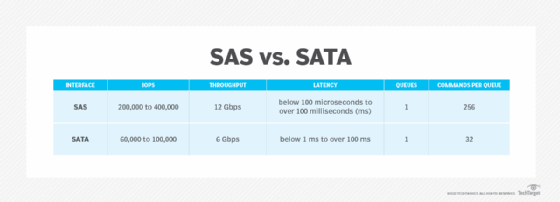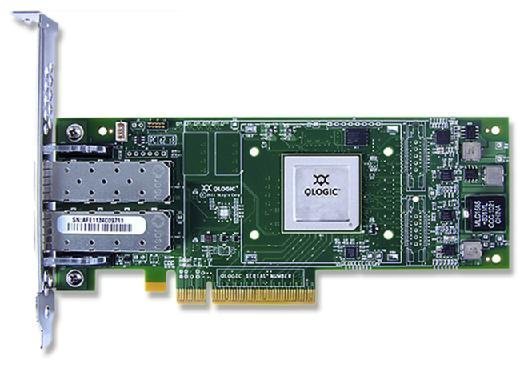Serial-Attached SCSI (SAS)
What is Serial-Attached SCSI (SAS)?
Serial-Attached SCSI (SAS) is a method used to access computer peripheral devices that employs a serial -- one bit at a time -- means of digital data transfer over thin cables. In the business enterprise, Serial-Attached SCSI is especially of interest for access to mass storage devices, particularly external hard disk drives and magnetic tape drives.
SAS is specified in the American National Standards Institute standard called Serial-Attached SCSI (Small Computer System Interface), also known as ANSI/InterNational Committee for Information Technology Standards (INCITS) 376-2003.
How does SAS work?
SAS is a protocol for point-to-point serial transmissions between storage devices and the computers they are storing data for. Point-to-point means that all data transfers across SAS are sent directly between the two communicating entities -- storage device and computer -- which are connected by a physical cable. Serial means that all data sent using SAS is transmitted a single bit at a time, in sequence.
The SAS protocol is implemented on computers to use a dedicated link among the computer and disk drives, tape drives and any other SCSI storage devices that are connected to the computer's host bus adapters (HBAs) over a serial interface.
A SAS system includes the following four basic components:
- Targets are storage drives that are connected to the SAS system.
- Initiators are used to send requests and handle responses from target devices. They are connected to the SAS device using a dedicated link.
- Service delivery subsystem is the component of the SAS system -- typically a cable, but it could include expander hardware for port expansion or a system backplane -- that links the targets, or storage devices, with the initiator of the SAS system.
- Expanders are an optional component of port multiplier hardware that enable port expansion in SAS systems so that multiple devices can be included in the SAS system. Expanders enable SAS systems to address as many as 65,535 storage devices.
The current SAS standard supports 255 direct connections, and storage devices, hosts or expanders can be connected to each of those ports. An expander can support up to 255 connections as well, giving an upper limit for SAS devices of 65,535 if each available direct connection is used for an expander.
Who uses SAS?
Serial-Attached SCSI is designed for businesses with substantial storage, backup and archiving demands. SAS is widely considered to be the prevalent interface for direct-attached storage and is used to support hard drive controllers in enterprise-grade server farms.
What are the advantages and disadvantages of SAS over other disk drive interfaces?
Before examining the advantages and disadvantages of SAS, it is important to consider that Serial-Attached SCSI is not the only widely used standard for disk drive interfaces. Other standards include the following:
- parallel SCSI, which defines protocols for using SCSI devices over parallel connections; and
- Serial Advanced Technology Attachment (SATA) standard for storage interfaces, which is the descendant of the ATA standard used for connecting storage devices to PCs.
Distinctions between storage interfaces depend on the use case, as differences in performance and cost matter more for high-end applications, like building large servers for data centers or high-performance mainframe systems.

Serial-Attached SCSI vs. parallel SCSI
SAS offers the following advantages over older parallel technologies:
- Serial cables are thinner and can be longer than parallel cables, and serial connecters are less bulky than parallel connectors.
- SAS offers higher transfer speeds than parallel SCSI standards.
- The hardware for serial interfaces is less costly than the hardware for equivalent parallel interfaces.
- SAS supports up to 65,535 devices on an interface; parallel SCSI supports a maximum of 16 devices attached to the HBA. Since SCSI is a peer-to-peer protocol, at least one of the ports must be used by a host, and up to 15 of the remaining ports can connect storage devices.
- Serial SCSI standards are more current and continue to be updated to expand SAS capabilities.
- Problems related to crosstalk are less likely in serial interfaces than in parallel interfaces because there are fewer conductors in the cables.
Because parallel interfaces transmit multiple bits in parallel, they can, in some cases, be faster than serial connections, which transmit sequential streams of single bits. However, parallel interfaces lose accuracy as cable lengths increase, so parallel interfaces are suitable only where cable runs can be kept short.
SAS supports up to 256 direct point-to-point connections, compared to the 15-device limitation common with parallel SCSI switches. With an expander, SAS can now support up to 65,535 storage devices attached to a single host. External disk drives, host adapters and expanders were the first devices to employ SAS.
As an older technology, parallel SCSI may be preferred for legacy applications where there is a sizable investment in parallel technologies.
Serial-Attached SCSI vs. SATA
SAS devices are compatible with SATA devices. In addition, SAS products are compatible with devices that use earlier SCSI technologies.
SAS offers the following advantages over SATA devices:
- SAS offers higher throughput rates than SATA.
- SAS is more reliable than SATA.
- SAS supports longer cable runs between devices than SATA.
- SAS is generally better suited for large server applications. SAS supports up to 256 direct point-to-point connections.
SATA devices offer the following advantages over SAS devices:
- SATA devices are optimized for storage capacity, while SAS devices are optimized for performance.
- SATA devices are less expensive than SAS devices.
- SATA cables are usually limited to runs of less than 1 meter.
SATA devices are most often found in PCs, while SAS devices are preferred for servers and other enterprise applications.

SAS standards
Serial-Attached SCSI standards are developed by the INCITS/T10-SCSI Storage Interfaces committee.
SAS-1, the first version of the SAS standard released in 2003, supported data bandwidth of 3 gigabits per second (Gbps). SAS-2 supports 6 Gbps, SAS-3 supports 12 Gbps and the current version, SAS-4, supports 24 Gbps. SAS-5 is under development and will support bandwidth greater than 24 Gbps.
Shared SAS
Shared SAS describes a method of attaching a storage array to multiple servers. It is considered an alternative to a storage area network, offering simplified management, backup and improved utilization. Users of shared SAS storage typically include small and midsize businesses or project workgroups within companies.
Drawbacks to shared SAS revolve around distance limitations. Users need servers that support SAS drives or may need to purchase SAS adapters.
Serial-Attached SCSI is popular for many applications, but the non-volatile memory express (NVMe) protocol has become the standard for solid-state drives and other non-volatile memory subsystems. Find out how NVMe speeds compare to SAS and SATA.





